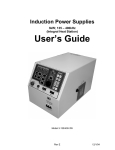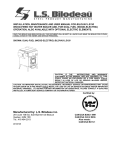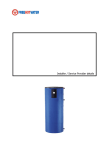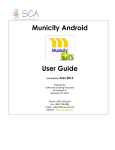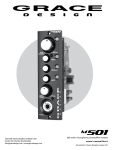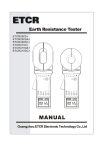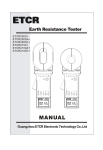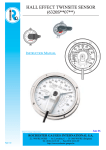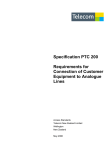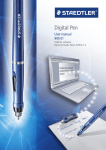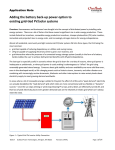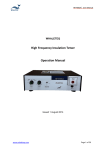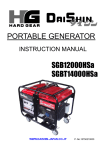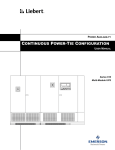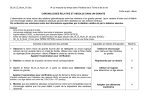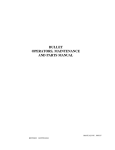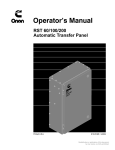Download User`s Manual - Precision Power Systems and Technology, Inc.
Transcript
Induction Power Supplies 5kW; 135 – 400kHz (Integral Heat Station) User’s Guide Model 5-135/400-3 5kW; 135-400kHz Rev. B 4/06 Table of Contents 1. Specifications and features................................................................................................3 2. Getting started.....................................................................................................................1 3. Connections ........................................................................................................................7 4. Front panel operation .........................................................................................................9 5. Programming in Auto mode…………………………………………………………………....13 6. Load station tuning………………………………………………………………………………15 7. Display and User Interface ......................................................................................... …..19 2 1. Specifications and features 1.1. Output Maximum Power 5kW1 Maximum Apparent Power 10kVA @ 230V input Minimum Power Factor 0.5 @ 230 V input Duty Cycle 100% Maximum Voltage 500V rms 2 Frequency 135kHz to 400kHz Maximum Response Time 0.1s3 Minimum Allowed OFF-Time 0.5s 1.2. Input AC line-to-line voltage 208V – 240V ± 10%, 3φ, 50 to 60Hz AC line current 14.5A @ 230V AC power 5.8kVA 1.3. Physical Dimensions: Length 23.5in (597mm) Width 14.5in (368mm) Height 14.0in (356mm) Weight 55lb (25kg) 1 5kW is output power. 5.8kVA input power allows for losses in the power supply. Limited by rating of resonant capacitors. Consult manufacturer for operating at output voltages above 500V rms. 3 When using the adjustable start-frequency feature. 2 3 1.4. Front panel controls and indicators LED Indicators Yellow indicator for power limit. Yellow indicator for voltage limit. Yellow or red indicator (dual color) for inverter current limit or trip respectively. Yellow or red indicator (dual color) for frequency limit or trip respectively. Individual red indicators for door, temperature, flow and/or auxiliary interlock trips. Numeric Displays Run time read-outs for output voltage, inverter current and frequency Power Meter (0-100%) Job number (Auto mode) Step (Auto mode) Step Time (Auto mode) Total time (Manual and Auto mode) Controls – Manual Mode Push button actuator with indicator light for Heat ON/OFF. Single turn knob for power level. (Manual mode) Pushbutton to reset trips. Rocker switch for manual or auto (programmed) operation. Emergency stop button. Freq button to select start frequency Controls – Programmed Mode Program, Job, Step, Freq, Pwr, Time/Freq, Clear and Enter buttons for programming automatic mode operation. 4 1.5. Internal heat station Resonant capacitors Mounting space provided for six capacitors. Four 210nF, 500V capacitors supplied. Capacitors available: 510nf, 570V 210nF, 500V Series inductor Adjustable for load matching, range .2uh to 2.4uh 1.6. Protection Resonant capacitor voltage Limited to 5kW in any feedback configuration Limited to 150A peak. Short circuit protected. Limited to 500V rms Line current 32A Circuit breaker DC link current 60A Semiconductor fuse Temperature and cooling water Temperature switch on inlet water. Differential pressure switch between water inlet and outlet. Safety Interlocks Emergency stop button or door switch opens the main circuit breaker. Power Inverter output current 1.7. Load Quality factor of load Connection Will operate with any load Q (including resistive loads), provided that the output frequency and voltage is within the specifications. Right side output 1.8. Cooling water Maximum pressure Minimum differential pressure Minimum water flow Maximum inlet water temperature 100PSI 30PSI .5GPM (690kPa) (207kPa) (0.032l/s) 105°F (41°C) Minimum water resistivity 590Ω.in (1500Ω.cm) Back of Cabinet Supply hose location 5 2. Getting started 2.1. Safety Warnings Have all operation, maintenance and servicing performed by qualified personnel only. 1. Read this operation manual completely before using the power supply. 2. Induction heating can be dangerous. Obey all warnings on unit and in manual. 3. Do not touch live electrical parts. In operation, this means the output connectors, the work coil, the work piece, and any buswork or cabling connecting them. WARNING: These symbols, placed at the outputs of the power supply, warn of the electric shock hazard there and RF burn hazard at the outputs when the unit is operating. Disconnect input power before installing or servicing this unit. The door interlock will open the breaker if the cover is removed. However, the input AC voltage is live at the top of the main circuit breaker. 2.2. Set-Up The following list describes the required actions to set up the power supply. 1. Loosen the two quarter turn fasteners and remove the cover from the unit. Check for any visual damage that could have happened during shipment. Check all plug-in connectors of PCBs. 2. Connect the heating coil to the output of the unit (see section 3.1. on page 7). 3. Connect and test the cooling water supply, as described in section 3 on page 7. 4. Do an initial setup of the internal heat station, as described in section 6.1 on page 15. 5. Read section 3.4. on page 9 to become familiar with the front panel controls. 6. Connect the remote loader to the front panel of the unit, as described in section 3.4 on page 8. The loader is not required for the operation. WARNING: Make sure that the power is locked out before connecting AC power to the unit. Connect only 208-240V, 3~. 7. Ensure that the circuit breaker on the unit is in the OFF position. Connect the power cord to a three phase supply as described in section 3.3. on page 8. 8. Do the tuning of the heat station, as described in section 6.2. on page 15. 9. The unit is now ready for operation, and can either be controlled by the front panel (control selection switches in INT position), or by the remote (control selection switches in EXT position, located inside door behind display panel). 6 3. Connections This section gives a description of the required steps to connect the load, cooling water, input voltage and remote loader to the unit. 1 2 3 Output for mounting of heating coil Power cord for connection to supply voltage source (plug not supplied) Water inlet and outlet for connection to cooling water source Figure 1: Load, cooling water and supply voltage connections. 3.1. Load Mount the heating coil to the side of the unit (see 1 in Figure 1 on page 7), using four 10-32 non-magnetic (e.g. brass) screws. Ensure O-rings are used to avoid water leakage. 3.2. Cooling water Connect the cooling water supply to the back of the unit (see 3 in Figure 1 on page 7). Two female ¼” NPT connections are provided. Turn on the cooling water flow and verify that it meets the minimum requirements as given in section 1.8. on page 5. Check for any water leaks on the inlet, outlet and heating coil. Tighten 7 connections if necessary. Also check for any water leaks inside the unit that could have been occurred during shipping, and tighten any hose clamps if necessary. 3.3. Three phase input voltage The unit is supplied with a 5 foot long cord (see 2 in Figure 1 on page 7). Install an appropriate plug on the power cord. Connect the plug to an appropriate supply voltage outlet socket and turn clock-wise to lock it into position. Note the requirements of the supply voltage given in section 1.2. on page 3. Ensure that a proper safety ground is connected to the ground terminal of the four wire socket. 3.4. D-sub connector (optional) A D-sub connector is provided on the front panel of the unit for RS-485 communications to a remote loader (optional). Connect the plug on the remote loader cord to the D-sub socket on the front panel of the unit, and tighten the screws on the plug onto the socket. See loader operation manual for instructions on setting up the remote loader. 8 4. Front panel operation This section identifies and describes the various parts of the front panel, and some internal settings. 1) 2) 3) 4) 5) 6) 7) 8) 9) 10) 11) Limit and trip LED Heat On/Off LEDs Program Indicators Volt, Curr and Freq Indicators Reset button Heat switch Figure 2: Front panel layout. 9 Power Knob Mode Switch RS-485 port Program Buttons Power Indicator 4.1. Limit and trip indicators and reset button. Identified by c in Figure 2 on page 9. Limit indicators: These indicators are yellow in color and are lit when the heat station is not properly tuned. The power output of the unit is limited below the desired level set by the power knob or remote pendant. There are four limit indicators: • POWER: If lit the power is being limited at 5kW. • VOLT: If lit the capacitor voltage is being limited at 500V rms. • FREQ: If lit the circuit is being limited at the resonant frequency of the resonant tank. • CURRENT: If lit the inverter current is being limited at 150A peak. (Note: The load coil current could be much higher than 150A peak). If any limit indicators are lit, the heat station components needs to be adjusted to obtain the required power (see section 6.2. on page 15). Trip indicators: These indicators are red in color and are lit if the unit is tripped. No power is being delivered to the load and the heat OFF indicator will be lit. There are six trip indicators: • FREQ: The circuit momentarily operated below the resonant frequency due to e.g. a short in the load or heat station component or poor tuning of the heat station components. • CURRENT: The inverter current momentarily exceeded the set maximum peak value due to e.g. a short in the load or heat station component of poor tuning of the heat station components. • DOOR: Indicates that the door of the unit is not closed. • TEMP: Indicates that the temperature of the inlet water has exceeded the allowable level. • FLOW: Indicates that there is inadequate differential water pressure. • AUX: An auxiliary interlock wired to the unit has tripped it. 4.2. Heat ON/OFF indicators. These LEDs show whether the power supply is generating output or is off. (identified by d in Figure 2 on page 9). 4.3. Program status indicators. Identified by e in Figure 2 on page 9. These read-outs display the programs status when using the AUTO mode. The STEP TIME indicator display minutes and the TOTAL TIME indicator displays seconds during manual mode operation. 4.4. Voltage, Current and Frequency Indicators. Identified by f in Figure 2 on page 9. These read-outs display the output voltage, the inverter current and the operating frequency when the power supply is operating. 10 4.5. Reset Button Identified by g in Figure 2 on page 9. This button is used to clear the fault indicators if a runtime or interlock trip has occurred. Depressing the button will light the limit and trip indicators and clear the latch for the fault indicator. If the LED does not go out, then the reason for the fault is still present. 4.6. Heat switch Identified by h Figure 2 on page 9. When the power supply is energized, and no fault indicators are lit, pressing the ON (-) button will start the power supply delivering heat. When moved back to the STOP (O) position, the heating will be terminated. While in AUTO mode, the ON position initiates the heat cycle. Pressing the STOP button will terminate the heat cycle. 4.7. Power Pot Identified by iin Figure 2 on page 9. The power pot sets the requested power level as indicated by the POWER read-out. The level of power feedback is indicated by the percentage on the LED display above the POWER POT. This pot is disabled during AUTO mode operation. 4.8. MODE switch Identified by j in Figure 2 on page 9. In the manual position, MAN, the power supply turns on with the HEAT switch and power level is controlled by the POWER POT. The programming the AUTO mode is done with the MODE switch in the MAN position. In the automatic position, AUTO, the power supply runs programmed jobs. The heat cycle is initiated with the HEAT switch and the power levels and duration of the cycle are controlled automatically, as programmed. 4.9. RS-485 port Identified by k in on page 9. This port can be used to connect a remote loader, or to monitor or control the power supply operation with a PC using our proprietary software. 4.10. Program buttons Identified by l in Figure 2 on page 9. The program buttons are used to program and display jobs for the power supply to run automatically. See section 5 on page 13 for a description of how to program the power supply. 4.11. Power Display Indicator Identified by (11) in Figure 2 on page 9. This read-out displays the demand power when the unit is in standby or program mode, and displays the power output when the heat cycle is in progress. 11 4.12. Control selection switches. The switches are located on the top of the display PCB, which inside the door behind the display panel. A label on the control board mounting bracket indicates their functions. SW1 INT/EXT: INTernal position: The Power knob controls the power level. EXTernal position: The power level is controlled by a user supplied 0-10V signal applied to TM1. See section 7 for more details. SW 0-10V: 4.13. Control selection The control used by the power supply can be selected by setting a jumper on the control PCB. The default is input power control (position J1). Output voltage (J2), auxiliary input (J3) and inverter output current (J4) can be selected. This circuit is designed so that the operator can select which function to control on the power potentiometer, provided the load does not change. Example: Selecting power: when the potentiometer is set to 50% the power supply will try to deliver 50% power or 2.5kW. If the jumper is set to Voltage control, 50% demand will result in 50% of 500 volts or 250V. For current 50% demand will display 75A. If the load changes accuracy is around 15%. 12 5. Programming in AUTO mode The power supply can be programmed 12 separate heating profiles or jobs. Each profile can contain 25 steps. The duration of each step can be up to 640 seconds. 5.1. Entering a program 1. Turn on the power supply and put the MODE selector switch in MANUAL. 2. Enter the program mode by depressing the JOB button for 2 seconds, until the Volt, Curr, and Freq displays go blank. The STEP will read 1 and JOB will display the last job used, or 1 if no other job was used. 3. If a heating profile has previously been entered in a Job, then the power and step time will be displayed on the PWR and STEP TIME readouts. 4. To clear an existing program select the job to be cleared, press the CLR button and then the ENT button, finally press and hold ENT for two seconds. 5. A power level and a time can be entered for up to 25 steps. The power level will ramp from the last power level to the power level requested. To get a power level quickly, set the time to 0.1 seconds and then set power to the desired level. Then set the next step to that power level and the time to the desired interval. 6. For each step, press PWR UP (S) and the PWR DOWN (T) keys to set the power level and press TIME/FREQ UP (S) and the TIME/FREQ DOWN (T) keys to enter a time up to 640 seconds. For longer intervals, several steps in a row can be set to the same power level. 7. Press STEP to move to step 2. Enter power level and time as in step six. 8. Press ENT (enter) display will enter into Ar mode or Auto repeat mode, press ENT again to store changes, or press JOB to move onto the next job. 9. Pressing the CLR button will exit program mode without saving changes. 5.2. Auto Repeat Function 1. Each JOB (except JOB 0, JOB 0 is a one step heat cycle) has an auto repeat function, which enables a selected job to be repeated up to 999 times. 2. To activate auto repeat press and hold JOB for more than one second, after selecting the job you want to repeat press ENT once, this will open the auto repeat function. 3. In the STEP window Ar will appear, in STEP TIME and in TOTAL TIME window 0’s will appear. The step time will indicate the “pause” time (indicated by a P in the STEP window) between repeat cycles and the TOTAL TIME will indicate the repeat number of cycles. 4. Press the TIME (S) (T) to increase or decrease the pause time. 5. Press the PWR (S) (T) to increase or decrease the number of repeat cycles. 6. Press and hold ENT for more than two seconds when completed. Note: When using any one JOB, a time of more than .3 seconds must be entered at any STEP and a power level of more than 1% entered to avoid an “AUX” trip. . 13 5.3. Running a program 1. With the MODE selector in manual, press JOB to enter program mode. Press the JOB key to select the job you wish to run. Press enter (ENT). 2. To view the job parameters before running the job, press the STEP button will display the power and time for each step. 3. Put the MODE selector switch in the AUTO position. 4. Put the HEAT switch in the ON position to run the selected job. 5. To run a program with a momentary on signal such as a footswitch: a) On TM-4 (internal terminal) connect footswitch wires to #1 heat and #5 common. b) Set E-H (external Heat) to EN (enable) as explained in section 5.3 below. 5.4. Enabling external connections. The external connections on Terminal Block TM-4 can be enabled from the front panel controls. Pressing the PROG button for 2 seconds will enter the parameter setting mode. The step button can be used to cycle through the parameters, and the TIME/FREQ UP and DOWN buttons can be used to change them. For these parameters, EN means Enable and DIS means Disable. E-H External Heat: Disable: The heat cycle is started by putting the heat switch in the on position. Enable The heat cycle is started by connecting terminal 1 and 5 on Terminal Block TM4. E-S External Emergency Stop: Disable: The terminal block connection for E-Stop is ignored. Enable: terminals 2 & 5 must be connected for the power supply to operate. When opened, the heat cycle is terminated, the circuit breaker will not be opened by the shunt trip, as it would by pressing the E-Stop button. E-A External Auxiliary Trip: Disable The terminal block connection for Auxiliary Trip is ignored. Enable When terminals 3 & 5 are not connected, an Auxiliary Trip will display on the front panel, and the unit will not operate. Note that the RESET function, terminal 4 & 5 is always enabled. There is no soft switch for this function. ADR Address: When the RS485 port is being used to control or monitor the power supply, a unique ID for the machine can be entered (00-99). BR Baud Rate: The communications baud rate for an RS485 connection can be set here (2.4, 4.8, 9.6, 19.2, 38.4 kbps). 14 6. Load station tuning. This section describes the procedures for tuning the heat station so that full power will be obtained at the desired frequency. WARNING: Always ensure that both the power supply’s circuit breakers are turned OFF when adjusting heat station components. 6.1. Initial setup. The following are the steps to be taken for the initial setup of the load station for a new heating coil and/or load: 1. Install all four load station capacitors. 2. Install the turns-bar in the 9 turns position and remove the two shorting bars. Section 6.3 on page Error! Bookmark not defined. describes the procedures for changing heat station components. 6.2. Tuning. This section provides the procedures required for the tuning of the heat station for a specific heating coil and load. It is assumed that the initial setup of the heat station has been completed as described in section 6 The aim of this exercise is to have the unit operating at full power (5kW) at the desired frequency (user specified between 135kHz and 400kHz) without any indicators lit. 1. Ensure that the heat switch on the front panel is in the OFF position, that the control selection switches are in the INT position and that the power level knob is turned completely counter clockwise (see). Check that the cooling water is turned on. The unit will not deliver power if the minimum differential water pressure specification is not met. 2. Turn on the 6A circuit breaker. The green OFF indicator should light up, indicating that the control circuitry is powered up. Press the reset button if any trip (red) indicators are lit. Ensure the emergency stop button is not pressed in and the door is closed. Turn on the 50A circuit breaker. 3. Press the ON button of the HEAT switch. Turn the POWER knob until the unit delivers approximately 10% power. If the frequency of the unit is not slightly above the desired (user specified) frequency, adjust the capacitance of the heat station and return to step 1. The required capacitance change is inversely proportional to the square of desired frequency change. Example: To increase the frequency by 40%, the capacitance has to be halved, and vice versa. The procedure for changing the capacitors is given in section 6.3 on page Error! Bookmark not defined.. 15 4. Once the frequency is acceptable, turn the power knob to maximum power (fully clockwise). • If the unit is not delivering full power and the frequency is indicated as ~135kHz (no limit indicators will be lit), the tank frequency is below the range of the unit. Decrease the capacitance and return to step 1. • If the current limit indicator lights up, continue increasing the inductance of the series inductors, i.e. increase the turns of the inductors, until the current limit indicator stops to light up at full power. Do the same if the current trip indicator lights up. Increase the turns in quarter turn increments by using the sliding bars, as described in section 6.3.2 on page 18. If the maximum series inductance still results in a current limit, a load matching transformer is required. • If the frequency limit indicator lights up, continue decreasing the inductance of the series inductors, i.e. decrease the turns of the inductors, until the frequency limit indicator stops to light up at full power. Do the same if the frequency trip indicator lights up. Decrease the turns in quarter turn increments by using the sliding bars, as described in section 6.3.2 on page 18. 5. If the inductance changes of the previous step caused the frequency to go out of the acceptable range, adjust the capacitance and return to step 1. 6. Increasing the series inductances until the current reading (inverter current) is less than 50% at full power will optimize the efficiency of the system. Highly recommended! 6.2.1. Start-frequency adjustment. The response time of the power supply, i.e. the time from the start of the heat cycle until full power is delivered, increases as the frequency at which power is obtained decreases. If full power is obtained at 135kHz, the response time approaches half a second. This is because the power supply starts at 440kHz and then needs to decrease the frequency until power is obtained. Lowering the start frequency will decrease the response time. Such a function is provided for applications where the operating frequency is relatively low and response times of less than half a second is required. By using this function the response time for any operating frequency can be reduced to less than 100ms. The “FREQ” button on the display is used for adjusting the start frequency dentified by lin figure 2 on pg 17. To set the start frequency, turn the power knob to about 20% power. Turn on the heat switch and note the frequency on the display after it stabilizes. Put the HEAT switch in the STANDBY position, press the “FREQ” button until it begins to flash. Press the “TIME” down arrow (T) until the frequency is the same as noted and then press enter. * *Care should be taken to avoid starting the power supply below the full power operating frequency; doing so will cause a current trip. 16 6.3. Changing the heat station components. This section describes the procedures for changing the heat station components. 6.3.1. Capacitors. Apply a thin layer of thermal grease to both tabs of each capacitor and install as indicated by 1 in Figure 3 on. Insert and tighten the mounting screws (four per capacitor). Capacitors can be mounted to both sides of the capacitor rails, and optimum current sharing is achieved when capacitors are directly opposing each other on the capacitor rail. WARNING: Make sure that the circuit breaker is turned off before adjusting heat station components. 1 2 Resonant Capacitor Brass mounting screw and silicon bronze lockwasher. Figure 3: Changing the capacitors 17 6.3.2. Series inductor. The turn selector bar is identified by c in Figure 4 on page 18. For the initial setup (section 6.2 on page 15) this is the only bar that is used and should be screwed onto the correct set of tabs to select the desired number of turns on the series inductor. The near position selects zero turns and the far position eleven turns, as indicated in Figure 4 on page 18. Tighten the bar into position using the mounting screws. The shorting bar has to be used for finer adjustment of the series inductance during the tuning (section 6.2. on page 15) of the heat station. Example: If the initial setup was for 4 turns (shorting bar not installed), and the turns needs to be decreased with a quarter turn, install the shorting bar in the low (3) position. If the shorting bar reaches the high (1) position and the inductance still needs to be decreased, remove the shorting bar completely and move the turns bar one position forward, e.g. from the 4 turns position to the 3 turns position. WARNING: Make sure that the circuit breaker is turned off before adjusting heat station components. 1 2 Turn selector bar (0 -11 turns) Variable shorting bar Figure 4: Adjusting the Series Inductor 18 7. DISPLAY AND USER INTERFACE There are two main ways of connecting the Power Supply to other devices for control purposes. The first is the 9 pin D-sub connector that is mounted on the front panel. The other way is to connect to terminal blocks within the unit. 7.1. Connecting to the D-Sub connector: This is a RS-485 port with Pin 5 as common, pin 6 as A and pin 7 as B. This connector is in parallel with TM-3 inside the power supply. 7.2. Display Board connectors There are five pluggable terminal connectors inside the power supply on the display board. They are labeled TM1 – TM5, and can be used to make various connections for monitoring the power supply or controlling the power supply functions remotely. TM1: Remote Power reference 1) 2) 3) 10V reference: This a 10V reference voltage for available for connecting to a potentiometer remotely. terminal to top of the pot, terminal 2 to the wiper and terminal 3 (ground) to the bottom of the pot. Remote Power Reference: When SW1, the INT/EXT switch is set to EXT, the voltage level at this terminal controls the command reference. O volts is minimum, and 10 volts is maximum. A PLC can be connected to terminal 2 with its reference to terminal 3. Reference Ground: Used with terminals 1 & 2, the ground for the power reference. TM2: Interlock connectors 1) 2) 3) 4) 5) Connection from temperature sensor on input water manifold Connection from differential pressure switch assembly Connection from door switch Common for pins 1,2,3 & 5. Auxiliary feedback: This pin accepts a zero to negative five volt DC signal for a user defined feedback to the power supply. The power supply will regulate power so that a given power demand gives an equivalent amount of feedback. (e.g. If the power knob is at 50%, then the power supply will bring up the power until the signal into the auxiliary feedback is at the 50% level, or –2.5V. TM3: RS-485 port 1) 2) 3) Common A B 19 TM4: Remote contacts These contacts are enabled by soft switches that are set from the front panel. See section 5.4. for further details. 1) 2) 3) 4) 5) START/STOP: Connecting terminal 1 to terminal 5 will start the unit. This is enabled when E-H is set to EN and the HEAT switch is ON. E-STOP: Opening a connection between terminal 2 and terminal 5 will stop the heat cycle. This is enabled when E-S is set to EN. This will not activate the shunt trip. The front panel E-STOP switch remains in circuit. AUX: A user defined trip can be wired between terminals 3 and 5. Enabled when E-A is set to EN. RESET: Connecting terminal 4 to terminal 5 will issue a fault reset. This is always enabled. COMMON TM 5: Relay contacts These are normally open contacts that have pin 4 as a common. 1) 2) 3) 4) 5&6) HEAT ON: FAULT: READY: COM: TRIP Connected to COM when HEAT cycle is on. Connected to COM when a FAULT occurs Connected to COM when the HEAT cycle is off and no faults exist. Common connection for the relays These are used by the power supply to sense a trip signal. NOTES: 20




















